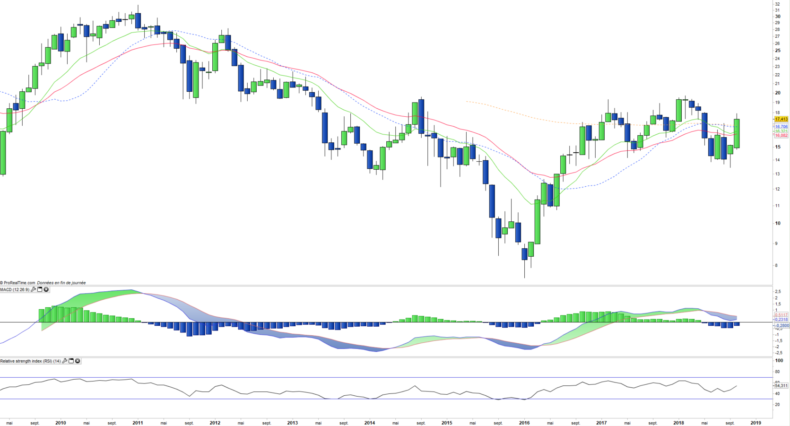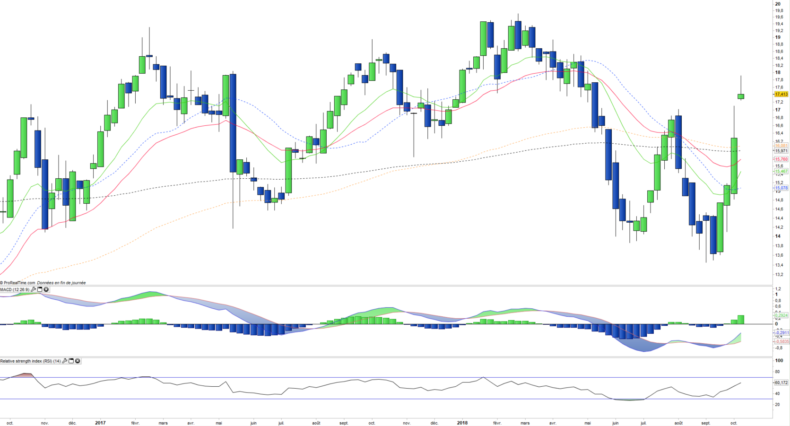Lyxor ETF Brazil Ibovespa - RIO - 09/10/2018
Short Term strategy: Positive (80%) / Trend +
Long Term strategy: Positive (70%) / Trend +
pour accéder à nos achats / ventes sur les indices
Characteristics of the ETF
The Lyxor RIO ETF (Brazil Index) created in 01/2007,is listed in Euro on Euronext and seeks to replicate the IBOVESPA index which is composed of the 65 main Brazilian stocks, selected according to the size of their market capitalization. This index covers 70% of the Brazilian market capitalization. The fees of this ETF are 0.65% and the AUM approximately 218M €. Replication is indirect (via Swap) and there is a dividend capitalization policy.
Alternative ETFs: BRZ (Amundi in USD), Ishares (EWZ in USD)
Index & components
The RIO (Lyxor) ETF is a very good proxy for the Brazilian economy.
Financials make up 32% of the index, basic materials account for 21%, and energy accounts for only 14,5%, after Petrobras fell sharply following corruption scandals.
Brazil is the ninth world economy with a GDP of $ 1800bn (the equivalent of Italy). After a period of very strong growth, the economy has been showing signs of slowing down since 2011 because of the stagnation of commodities prices for export, the slowdown in domestic consumption linked to household indebtedness and lower investments. In 2015 and 2016, the Brazilian economy plunged into recession (-3.5%) and fiscal difficulties increased but the country emerged from the recession in 2017 and is expected to post moderate growth in 2018, the year of the presidential election. The policy continues to punctuate the markets, after the dismissal of Dilma Rousseff, the imprisonment of former President Lula and the corruption scandals around the current President Tremer.
Attempts to adjust the budget and control inflation are on track but need to be deepened. However, with a population of more than 200 million, Brazil also has abundant natural resources and a relatively diversified economy. Brazil is the world's largest producer of coffee, sugar cane and oranges, one of the world's leading soybean producers, and the country attracts many global agribusiness and biofuel groups. Brazil is also a big industrial country. The exploitation of its mineral wealth has made it the world's second largest exporter of iron and one of the largest producers of aluminum and coal. As a producer of oil, Brazil is considering self-sufficiency in short-term energy production (its reserves could make it one of the top five oil producers).
The country is becoming increasingly important in the textile, aeronautics, pharmaceuticals, automotive, steel and chemical industries. Most major automobile manufacturers have established production units in the country.
Brazil has emerged from the recession and has strong medium-term growth potential, yet the country remains highly dependent on oil and commodities.
Latest developments
After a rise of nearly 73% in 2016, the recovery of the Brazilian index continued in 2017 with a performance of + 10.3%, and recorded a slight increase of 0.8% since the beginning of the year 2018, with a lot of volatility linked to the presidential election.
The Ibovespa index and the real rebounded sharply after the results of the first round on Sunday, which marked a clear victory for the right-wing candidate Mr Bolsonaro with 46% of the votes, which strengthens his favorite status in the second round against the leftist candidate. In case of confirmed election of the favorite business candidate, the visibility should return somewhat to the country that has emerged from the recession but is looking for momentum.
However, the rise in US long-term rates, the strength of the US dollar and the economic war that is likely to affect China as one of the country's major markets are threats facing the new government.
Monthly data
The monthly chart shows a trend that avoids "in extremis" to turn down after a sharp correction of 6 months before the presidential poll. The October candlestick is powerful, it goes above the moving averages 13 & 26 and absorbs much of the decline from May-June but will have to be confirmed by the end of the month. The technical oscillators are recovering and confirm the bullish reversal.
Weekly data
On the weekly chart, we can observe a double dip that has just been validated with a bullish gap, which will have to be confirmed at the end of the week. The oscillators have turned upward and confirm the movement which should move towards the highs of the year at around 19 €. The upward crossing of the EMAs13 and 26 will confirm the change of trend in the medium term.
ETF Objective
RIO is a UCITS ETF, listed in EUR, which seeks to replicate the Ibovespa Brasil Sao Paulo Stock Exchange Index (65 companies)
Characteristics
| Inception date | 24/01/2007 |
| Expense ratio | 0,65% |
| Benchmark | Ibovespa Brasil Sao Paulo Stock Exchange Index |
| Ticker | RIO |
| ISIN | FR0010408799 |
| Currency | € |
| UCITS | Yes |
| EU-SD Status | Out of scope |
| Exchange | Euronext Paris |
| Assets Under Management | 215 M€ |
| Replication Method | Indirect (Swap) |
| Dividend | Capitalization |
| PEA (France) | No |
| SRD (France) | Yes |
| Currency Risk | Yes |
| Number of Holdings | 65 |
| Risk | 4/5 |
Country Breakdown
| Brazil | 100% |
Sector Breakdown
| Financials | 32% |
| Materials | 20% |
| Energy | 15% |
| Consumer Staples | 11% |
| Consumer Discretionary | 7% |
| Industrials | 5% |
| Utilities | 4% |
| Others | 6% |
Top Ten Holdings
| Vale | 13% |
| Itau Unibanco | 11% |
| Banco Bradesco | 7% |
| Petrobras - Petroleo Bras | 7% |
| Ambev | 6% |
| Petrobras - Petroleo Bras | 5% |
| BM&FBOVESPA | 4% |
| Itausa investimentos | 3% |
| Banco do Brasil | 3% |
| Lojas Renner | 2% |


